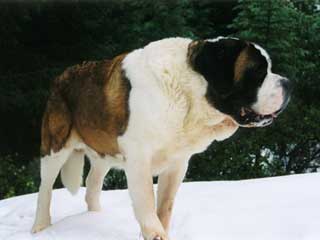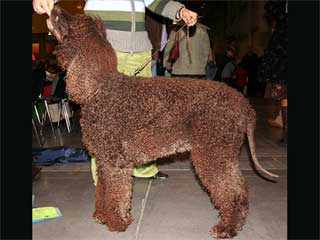| Grooming: |  |  |  |  |  |  |
| Shedding: |  |  |  |  |  |  |
| Energy Level: |  |  |  |  |  |  |
| Protection: |  |  |  |  |  |  |
| Watch Dog: |  |  |  |  |  |  |
| Group: | Working |
| Size: | Large |
| Life Span: | 8-10 years |
| Height: | Male: 27.5-30 inches |
| Female: 25.5-28 inches | |
| Weight: | Male: 150-180 lbs |
| Female: 130-160 lbs |
Saint Bernard Facts
| Coat : | Smooth and dense |
| Gait : | Powerful |
| Color(s) : | Various shades of red, brown, black or brindle, always with white markings |
| Living Area : | Any |
| Hair Length: | Short Or Long |
| Exercise Need : | Daily long walk |
| Recognized By : |
(CKC) Canadian Kennel Club (FCI) F�d�ration Cynologique Internationale (AKC) American Kennel Club (UKC) United Kennel Club (KCGB) Kennel Club of Great Britain (CKC) Canadian Kennel Club (ANKC) Australian National Kennel Council (NKC) National Kennel Club (NZKC) New Zealand Kennel Club (APRI) America Pet Registry, Inc. (ACR) American Canine Registry (DRA) Dog Registry of America |
| Date of Origin : | Ancient |
| Place of Origin : | Switzerland |
| Todays Use : | Companion Dog |
| Originally Used : | Guard dog |
| Other Name : | St. Bernhardshund, Bernhardiner |
Saint Bernard Information
Saint Bernard Description:The Saint Bernard belongs to the lineage of molosser dogs such as Sennunhunds which were used as farm dogs and rescue dogs in the Alps. This breed of dog derives its name from the St. Bernard Pass, which is located between the Swiss Alps and Italy. Originally, the Saint Bernard was a short haired mountain dog which was primarily used for rescue purposes. However, in the 17th century, the breed began declining in numbers because of increased instances of avalanches in the Alps. To save the breed, it was crossbred with the Newfoundland breed and thus the modern variety was born. This breed was first recognized by the AKC in 1885. |
Saint Bernard Care & Grooming:The Saint Bernard is an average shedder and usually sheds twice in a year. Regular brushing with a firm bristle brush is required to keep its coat healthy. It should be bathed only when required using a mild shampoo. The breed is prone to eye infections so special care needs to be taken of their eyes. It tends to gain weight so should not be overfed. This dog is sensitive to warm climate so care should be taken while taking them out. It drools and there is no way to avoid it. |
Saint Bernard Health Problems:The Saint Bernard prone to some health issues like bloat, skin allergies, hip dysplasia, heart problem, eye infection etc. |
| Group: | Sporting |
| Size: | Large |
| Life Span: | 10-12 years |
| Height: | Male: 23-26 inches Female: 21-24 inches |
| Weight: | Male:65-80 lbs Female: 55-70 lbs |
| Color: | Brown, red, sedge or deadgrass |
| Description: | The origin of the Chesapeake Bay Retriever goes back to the early part of the 1..... |











